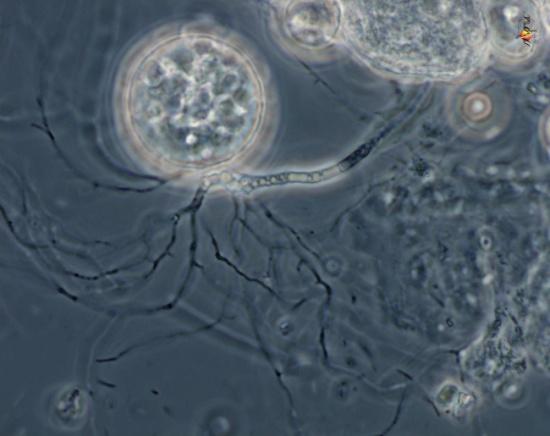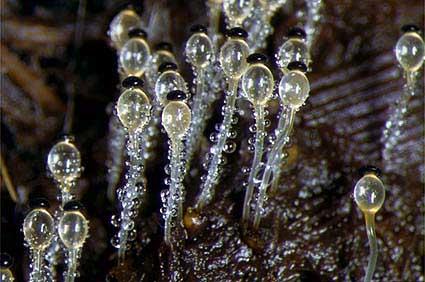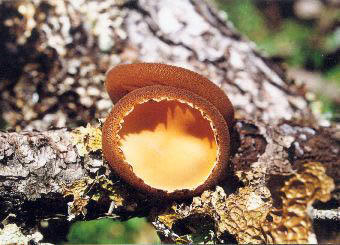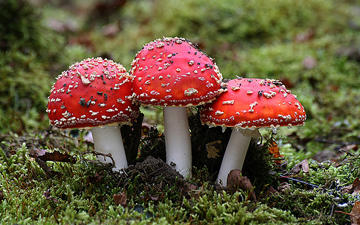Distinguishing characteristics
Fungus (fungi) is a member of the group of eukaryotic organisms that also includes unicellular microorganisms like yeasts and mold, along with multicellular fungi that are also known as mushrooms (Characteristics of fungi, n.d.). They are classified as a kingdom Fungi and are separated from other kingdoms.
The main feature that differs fungi from plants is chitin in their cell walls (Characteristics of fungi, n.d.). They are heterotrophs and acquire food in a unique way by absorbing molecules and secreting digestive substances into the environment that surrounds them. They are also characterized by the complex reproduction system. The third part of fungi uses more than one method of propagation. It might be either asexual reproduction via spores or through mycelial fragmentation, or sexual reproduction with meiosis which is different from those of animals and plants (Carris, Little, & Stiles, 2012). There are also both microscopic and macroscopic structures. Fungal mycelia can be visible by the naked eye. Their traditional habitat includes damp and dusk places, spoiled food, etc. This environment triggers their growth and contributes to their fast spread.
Representative members of this taxonomic group
The given taxonomic group counts a number of various members and subgroups as it is widely spread all over the world and could be found on every continent.

Chytridiomycota is a division of the kingdom Fungi. It reproduces with zoospores and could be classified by the absence of mycelium which makes them the most primitive in the kingdom (Ashwati, n.d.).
Dikarya is a subkingdom of Fungi. This class is often called higher fungi because of their complicated structure and other unique characteristics that differ them from other representatives of the kingdom.

Zygomycota is another representative of the kingdom. Lives in soil or on decaying plant or animal. Its hyphae might be coenocytic (Ashwati, n.d.).


Ascomycota is a large phylum of Fungi with over 64000 species (Ashwati, n.d.). The ascus in which spores are formed could be considered the unique feature of this kind.
Basidiomycota is one of two large phyla It also includes mushrooms, puffballs, boletes, etc. It is composed of hyphae and reproduces sexually with the help of basidia (Ashwati, n.d.).

The ecological significance of the group
The ecological importance of this group could hardly be overestimated. First, they are a crucial element of the lifecycle as they decompose various substances that appear near them. In such a way they contribute to the efficiency of numerous processes that occur in nature. Additionally, they could be considered natural purifiers that absorb numerous substances and process them. A number of representatives of this group are parasites which cooperate with other organism and play a significant role in its functioning. Besides, mushrooms are an essential product that is the part of a menu of every person. They provide needed elements and substances. Besides, antibiotics are also obtained from fungi. The discovery of this very medicine was revolutionary and altered the way the healthcare sector evolved. That is why all representatives of the kingdom of fungi play a crucial role in peoples life.
Population density and biodiversity
In conclusion, fungi have a worldwide distribution and could be found all over the world. They grow both in deserts with high salt concentration, in deep sea sediments, or in areas characterized by extreme frost. At the moment, there are about 100000 species that are discovered by taxonomists all over the world (Ashwati, n.d.). However, the global biodiversity of this kingdom is still not clear. Specialists predict that there are over 5 million species that have not been discovered yet (Carris, Little, & Stiles, 2012).
References
Characteristics of fungi. (n.d.). Web.
Ashwati, P. (n.d.). Taxonomic groups of fungi. Eukaryotic organisms. Web.
Carris, L., Little, C., & Stiles, C. (2012). Introduction to fungi. Web.